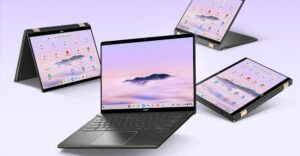
Boy, the hits just keep on coming. Last week was no exception, with moves that further put to rest the idea that the tech market is dull and boring.
Dell released four products in Los Angeles, two of which are some of the most aggressive ever to come from that company. Hewlett-Packard launched another 100 products — though the story wasn’t the products but what some folks are doing with them — and AMD sent a shot across Intel’s bow with its anti-Viiv ‘Live’ offering.
Dell Makes Prototypes Real
A couple of weeks ago in my coverage of E3, I talked about two prototype PCs that Dell was building. Well, last week Dell released them to an eager market that had previously bought every one of the firm’s available US$10,000 performance desktop systems at a record rate.
The most compelling of the products were the firm’s new laptop, which is more of a next-generation portable TV, and a new gaming desktop system that doesn’t look like it was simply stuffed into a workstation case and painted creatively.
The XPS M2010 laptop looks wild open but looks even wilder closed. With a 20-inch screen and battery power, this would be an interesting product to attempt to even get onto a plane, let alone use there. You’d probably have to buy an entire row of seats just so you had the distance you would need to watch movies properly on it.
This thing would be great for business presentations and has enough power for most games, though it is clearly meant more for media viewing than for gaming. Still, can you imagine walking into a meeting and setting this puppy down? At the very least you’d get everyone’s attention.
The XPS 700 gaming machine reminds me a lot of the pod racers in “Star Wars Episode One.” The outside has a very clean aluminum shell and the inside shows nice attention to detail, with kind of a premium car feel. It is an Intel, rather than an AMD, box but it has a strong video configuration. Just look at the cable management: This is the quality of work you typically only get from the gaming companies. It showcases just how serious Dell is about this market.
The least exciting product among Dell’s new offerings is the M1210 ultra portable. Compared to the other products, this looked old to me out of the box.
Toshiba launched a similar machine, the Tecra M6, and Lenovo launched the V 3000. I thought both of those had more compelling industrial designs than the Dell did, and all three followed Gateway’s NX100X to market. Of course, I still think the gold standard in this class is the Voodoo Envy a:228.
Finally, Dell UltraSharp 24-7WFP is the product among the four launched by Dell last week that will probably garner the highest sales because its predecessor was so incredibly popular. In fact, I think it will become the most lusted after monitor in the performance space. The only product I’ve seen compete with it is the Gateway FPD2185W 21-inch monitor, which is about $400 less expensive.
My concluding thought about all of this is that the idea of publicly showing off prototypes and then building them if folks get excited is what has made a number of hot cars possible, and it’s working for Dell, too. If more manufacturers do this in the future, we are going to get some incredibly cool products that otherwise might have never seen the light of day.
HP’s Big Bang
About once a year HP does a massive product launch, and last week it did so with offerings from its printer division. The number of products was, indeed, massive. The most interesting was a touch screen photo printer which could give a kiosk-like feel to those who want an in-store photo experience without having to go to the store.
With this year’s launch, though, the really interesting stories were the ones going on behind the scenes, so let’s talk about those instead.
Evidently, in Asia, HP printers and scanners have been selected to preserve a variety of very large and very old works of art. HP scans the artwork and then prints out nearly identical reproductions which are then put up for display instead of the vastly more fragile ancient original pieces. These originals are then put in a climate-controlled vault where they will remain as they are indefinitely. This process, which allows for preservation of valuable cultural artifacts, used to require duplication by hand. Amazingly, today’s industrial printers now have the capability to make copies that curators believe are museum quality.
The other interesting story involves Halo, one of my favorite HP products, probably because there is no way in hell I’ll ever be able to afford a Halo system. Halo is HP’s high definition video conferencing system, which now enables multi-site viewing. Third-party research indicates that the system is truly providing substantial improvements in productivity and significantly reducing firms’ travel hassles and expenses.
The most interesting deployment I know of is one in Jerry Seinfeld’s home, where Halo allows him to collaborate with associates on a movie without ever having to leave his house. This technology has the potential to eliminate the need to go into the office one day. Of course at nearly $500,000, however, the number of folks that will have this in their home will be rather limited for quite a while. Still, it sure beats a home theater for exclusivity. I’m guessing it will become the next big thing in Christmas gifts for the rich and famous.
AMD Goes ‘Live’
AMD last week rolled out its “Live” offering to compete with Intel’s Viiv. In both cases, the initiatives will live or die on content, which has so far been the Achilles’ heel of the Media Center PC.
I haven’t had a chance to play with this yet, but this focus on content by both firms does show that they get why Media Centers aren’t used often these days and that fixing this will entail a huge focus on content. AMD partnered with Orb, which provides one of the best PC-based media distribution services available. It has also tied in with Network Magic, a company with heavy Intel roots, interestingly enough, to make the system vastly easier to set up wirelessly. A product called LogMeIn further enhances remote access.
The real test will be in how easy all this stuff is to use and how well it integrates with Microsoft’s Media Center platform. I can see an AMD Live vs. Intel Viiv slapdown coming up later this year and, regardless of who wins or loses, the consumer can only win if we get access to the content we want to watch and listen to. Of course, the third player in any showdown will be Apple, which might end up using Intel technology to take the segment. That last possibility is what helps make this next quarter a time to look forward to.
Rob Enderle is a TechNewsWorld columnist and the Principal Analyst for the Enderle Group, a consultancy that focuses on personal technology products and trends.



















































